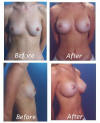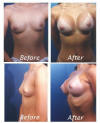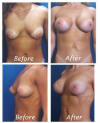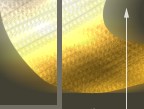



Procedures
Breast Augmentation
See the Photo Gallery
Call to request information or schedule a consultation: Contact Us
Introduction: The decision to seek breast augmentation, known more technically as augmentation mammoplasty, is a personal one. Breast augmentation is a safe and effective procedure to enlarge the breasts and enhance their shape, fullness and your overall bodys proportions. Most women seeking this procedure do so due to their belief that their breast size is not consistent with their overall physique. Among the reasons our patients have sought breast augmentation are: failure of the breast to develop fully, breast volume, asymmetry, shape, and for fullness lost after pregnancies or breast-feeding. Our patients range in age from 18 to 60, with most occurring in the middle of this range. The following sections will first provide more technical information about breast augmentation and then discuss our careful approach to providing you with the best possible care and concern before, during, and after your procedure.
Breast anatomy: The breast consists of milk ducts and glands, surrounded by fatty tissue that provides its shape and feel. Beneath the breast is the pectoralis major muscle (chest muscle), which indirectly affects breast projection. Elasticity of the skin covering the breast also contributes to its shape. As Mother Nature would have it, naturally occurring breasts are seldom symmetrical in size, shape, and horizontal positioning.
Candidates for breast augmentation: Breast augmentation can enhance your appearance and self-image. It may not provide results that may match your opinion of ideal. It is important for you to consider your expectations and to discuss them with Dr. Shienbaum before you have your surgery. While the Doctor is highly adept, having performed thousands of breast augmentations for over 20 years, you must understand that those who seek unattainable results will not be satisfied.
The best breast augmentation candidates, therefore, are those women, in good health who are looking for improvement, not perfection.
There are several factors that deem some women as non-candidates for breast augmentation. These include existing malignant or pre-malignant cancer of your breast without adequate treatment, patients will active infections anywhere in the body, and women who are pregnant or currently breast-feeding.
Types of implants: Most augmentation mammoplasty involves placement of a silicone shell or sac that is implanted under your tissues and then filled with sterile saline, or saltwater. One shell is used for each breast. The United States Food and Drug Administration (FDA) has approved these implants, which are available on an unrestricted basis. In the unlikely event that a saline implant leaks, the saltwater is harmlessly absorbed by the body.
Implants come in two shapes, teardrop (anatomical) and round. Dr. Shienbaum prefers the round implant and generally reserves the teardrop implant for breast reconstruction procedures. The implants are also available with a smooth or a textured surface. Dr. Shienbaum has found the round, non-textured implant to be the most successful. The implants he uses carry a lifetime replacement policy from the manufacturer. Specific replacement details are provided to patients during their complementary consultation.
Surgical procedures:
The technique used for your surgery is dependent on your
specific anatomy and the desired results.

There are three incision
locations normally used in breast augmentation: in the crease
underneath the breast, around the lower edge of the areola (the
dark skin around the nipple), or within the armpit. In all
cases, the incision is made to keep scars as inconspicuous as
possible. Following the incision, Dr. Shienbaum creates a pocket
that accepts the implant. This pocket is made either directly
behind the breast tissue or beneath the pectoral muscle below
the breast tissue and above the chest wall. As previously noted,
placement of the incisions and locations of the pockets are
dependent on your individual anatomy and desired results.
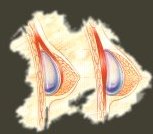
While breast augmentation is relatively straightforward, all surgeries carry some risks and uncertainties. The most common problem is known as capsular contracture. In this condition, the ensuring internal scar or capsule that surround the implant begins to tighten, squeezing the implant and causing the breast to feel hard. All augmentation mammoplasty patients receive instruction on prevention of capsular contracture.
As with any surgical procedure, excessive bleeding following the operation may cause some swelling and pain. Infection or inflammation surrounding the implant have also been reported in the literature. This may occur at any time but is most often seen within a week after surgery.
Planning your surgery: Dr. Shienbaum and his staff at Brandon Plastic Surgery welcome you to a complementary initial consultation during which your desires will be discussed. In your initial consultation, you will visit with the professional staff that will take your medical history. The Doctor will evaluate your health, conduct an examination, and recommend which surgical technique is most appropriate for you. It is important for you to be frank with the Doctor and for you to know that the Doctor will be frank with you, describing his technique, alternatives, limitations, and risks. Dr. Shienbaum also will explain the anesthesia that will be used during your procedure. The staff will provide you with the opportunity to be fitted with several sizes of implants appropriate to your anatomy and also will provide you with photos of previous patients so that you may better comprehend likely results. The facility where your surgery will be performed will be explained, as will the expenses involved. Insurance carriers generally do not cover augmentation mammoplasty, since they generally deem it to not be medically necessary.
Upon your decision to proceed with augmentation mammoplasty, the staff will work with you to arrange a surgery date, discuss the implant manufacturers lifetime replacement policy, review consent forms, and take photographs. Dr. Shienbaum uses an advanced digital imagery camera and storage on an automated imagery filer to immediately record photographs.
The staff will also provide you with instructions in preparation for your surgery. These will include guidance on eating, drinking, smoking, and the taking or avoidance of certain medications and vitamins. You will need to arrange for transportation from the facility and should have some assistance to help or to provide care following your surgery.
Where your surgery will occur? Dr. Shienbaum will perform your breast augmentation in a local, fully accredited ambulatory surgical facility. While augmentation mammoplasty is typically conducted in an outpatient facility, Doctor Shienbaum has privileges at area hospitals where he is recognized as a board-certified Plastic Surgeon and Otolarnygologist.
Your surgery and anesthesia: Upon your arrival for your surgery, all pre-operative laboratory work will be accomplished and the anesthetist will initiate an intravenous (IV) line. The IV will be used to provide your anesthesia and appropriate medications and hydration during the surgery and your recovery period. Depending on your case and the facility, either general anesthesia or a shallower sleep , known as IV sedation, are usually employed.
Augmentation mammoplasty normally takes one to two hours to complete. As discussed above, the technique used for your surgery is dependent on your specific anatomy and the desired results. One of three incision locations is normally used: in the crease underneath the breast, around the lower edge of the areola (the dark skin around the nipple), or within the armpit. In all cases, the incision is made to keep scars as inconspicuous as possible. Following the incision, Dr. Shienbaum creates a pocket that accepts the implant. This pocket is made either directly behind the breast tissue or beneath the pectoral muscle below the breast tissue and above the chest wall. Dr. Shienbaum uses a strict sterile No
Touch technique for insertion of all implants. Sutures are used to close the incision, which may also be taped for greater support and drainage tubes are frequently placed beneath the skin to minimize swelling. In addition, an ace wrap will be placed firmly around your chest to provide support and to help reduce swelling. After completion of your surgery, you will be moved to a recovery room or area.
While in recovery a nurse will be constantly monitoring your vital signs and will ensure that you are comfortable. Recovery time is dependent on the anesthesia used and your individual physiology. A normal recovery stay of one to two hours should be expected. A member of Dr. Shienbaums nursing staff will contact you in the evening to check on your status. It is important that you provide the staff with a contact phone number.
After your surgery: You will likely feel sore the first 24 hours after your procedure and you should expect swelling and discomfort in your breasts. You will be seen in our office on the day following your surgery. During this visit you will be evaluated, your dressings changed, drains removed, and provided with further post-operative instructions, as needed. The staff will assist you in applying your sports bra that you will wear for approximately one month.
You should expect to be up and around in 24 to 48 hours following the surgery. Most discomfort that you experience will be controlled by medication, but should subside within 3 to 4 days. Any expected bruising and swelling from the procedure should disappear within 2 to 4 weeks. Any complications noted should be immediately brought to the attention of Dr. Shienbaum.
Follow-on examinations will be scheduled based on your physiological progress.
You should be able to resume most non-physical activities within 1 week. Your breasts will likely be sensitive to direct stimulation for 2 to 3 weeks. Scars will be firm and pink for at least 6 weeks, may remain the same size for several months, and then will fade. Most patients are completely healed and back to full activities within 4 to 6 weeks.
Frequently asked questions: This section provides information in response to questions or subjects routinely posed by our patients:
1. Nipple sensitivity/nipple numbness. Numbness may occur temporarily or permanently from traumatizing sensory nerves in the breast during the procedure. Industry-wide, the risk is normally less than 1%.
2. Childbearing and nursing. There is no evidence that breast implants will affect fertility, pregnancy, or your ability to nurse. Most people are successful at breast-feeding after implants, but not all. (It should be noted that some women that never had augmentation mammoplasty cannot breast feed.) If you have nursed a baby within a year of your surgery, you may produce milk for a few days after the surgery.
3. Resumption of activities. Dr Shienbaum recommends a return to as much activity as is comfortable 2 to 4 weeks after your surgery. At this point you have healed and the risk of bleeding is past. Implants under the pectoralis muscle are not usually a problem with patients who are normally involved in physical exercise.
4. Mammography and breast cancer. There is no evidence that breast implants cause breast cancer; however, they may change the methods mammography is accomplished to detect cancer. Your routine tests should be performed at a center where technicians are experience in the techniques required to get an accurate image of a breast with an implant. Additional views may be required and ultrasound examinations may be of benefit in some women with implants to detect nodes or to evaluate the implant.
5. How long do implants last? The exact length of time that an implant lasts is unknown, but a normal expectancy is ten to twenty years. It is very rare that an implant will fail (rupture) within a year; however, occasionally they may break or leak as a result of injury or from normal compression and movement of your breast and implant. Should an implant break, it will deflate and the saline solution will be harmlessly absorbed by your body.
813-681-5709
Home
~~ Contact
Us ~~
Practice Info
~~ Dr.
Shienbaum ~~
Photo Gallery






